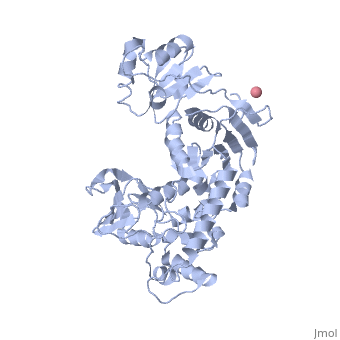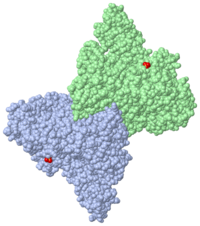Transcription-repair coupling factor
From Proteopedia
(Difference between revisions)
| Line 1: | Line 1: | ||
<StructureSection load='3hjh' size='400' side='right' scene='' caption='Transcription-repair coupling factor complex with Co+2 ion (red), [3hjh]]'> | <StructureSection load='3hjh' size='400' side='right' scene='' caption='Transcription-repair coupling factor complex with Co+2 ion (red), [3hjh]]'> | ||
[[Image:2eyq.png|left|200px|thumb|Crystal Structure of Transcription-repair coupling factor [[2eyq]]]] | [[Image:2eyq.png|left|200px|thumb|Crystal Structure of Transcription-repair coupling factor [[2eyq]]]] | ||
| + | |||
| + | |||
| + | |||
| + | |||
| + | |||
| + | |||
| + | |||
| + | |||
| + | |||
| + | |||
'''Transcription-repair coupling factor (TRCF)''' enables the coupling of these processes in bacteria and humans. The TRCF has ATPase activity. <scene name='2eyq/Asymmunit/2'>The crystallographic asymmetric unit of the solved structure contains 2 monomers of Mfd (residues 2-1147 of 1151 for one molecule and 5-1147 of the other), five HEPES molecules, and the sulfate ions.</scene> | '''Transcription-repair coupling factor (TRCF)''' enables the coupling of these processes in bacteria and humans. The TRCF has ATPase activity. <scene name='2eyq/Asymmunit/2'>The crystallographic asymmetric unit of the solved structure contains 2 monomers of Mfd (residues 2-1147 of 1151 for one molecule and 5-1147 of the other), five HEPES molecules, and the sulfate ions.</scene> | ||
Revision as of 08:41, 11 August 2013
| |||||||||||
Reference
- Deaconescu AM, Chambers AL, Smith AJ, Nickels BE, Hochschild A, Savery NJ, Darst SA. Structural basis for bacterial transcription-coupled DNA repair. Cell. 2006 Feb 10;124(3):507-20. PMID:16469698 doi:10.1016/j.cell.2005.11.045
Created with the participation of Wayne Decatur
Proteopedia Page Contributors and Editors (what is this?)
Karsten Theis, Michal Harel, Alexander Berchansky, Wayne Decatur


